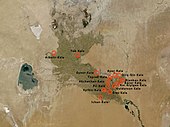Koi Krylgan Kala
Archaeological site in Uzbekistan From Wikipedia, the free encyclopedia
Koi Krylgan Kala (Uzbek: Qoʻyqirilgan qalʼa; Russian: Кой-Крылган-Кала) is an archaeological site located outside the village of Taza-Kel'timinar in the Ellikqal'a District (Uzbek: Ellikqalʼa tumani; Russian: Элликкалинский район) in the Republic of Karakalpakstan, an autonomous republic of Uzbekistan. In ancient times, it was sited along a canal in the Oxus delta region.
 Koi Krylgan Kala (reconstruction) | |
| Alternative name | Koi Krylgan Kala |
|---|---|
| Location | Karakalpakstan, Uzbekistan |
| Coordinates | 41°45′18.77″N 61°7′1.22″E |
| Type | Settlement |
| History | |
| Periods | Parthian, Sasanian |
| Site notes | |
| Excavation dates | 1938 |
| Condition | Ruined |
Wikimedia Commons has media related to Koi Krylgan Kala.
There is some relationship between Koi Krylgan Kala and Toprak-Kala, 30 km to the northwest.[1] It is a temple complex of the Chorasmian Dynasty, an Iranian people who ruled the area of Khwarezm. It was built in the 4th-3rd century BCE.[2] The Apa-Saka tribe destroyed it c. 200 BCE, but later it was rebuilt into a settlement, which lasted until c. 400 CE.[3] It was discovered in 1938 by Sergey Pavlovitch Tolstov, leader of the Chorasmian Archaeological-Ethnological Expedition. It contained a Mazdian fire temple and was decorated with frescos of wine consumption.
The explorer Sergey Tolstov drew a reconstruction of the ancient fortress.[4]
- Statue of a man-ossuary from Koi Krylgan Kala, first centuries A.D., Hermitage Museum
- Location of the Koi Krylgan Kala fortress in the Chorasmian oasis, in relation to other main fortresses
Notes
References
Wikiwand - on
Seamless Wikipedia browsing. On steroids.




